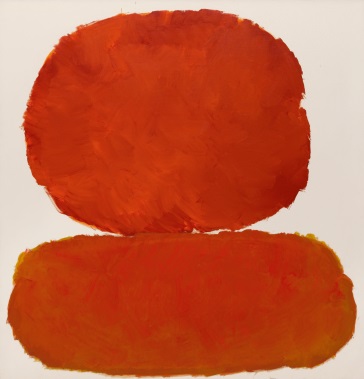Some Thoughts on Concept and Craft
Raymond Parker, Untitled, 1959
While Pop art constantly referred to contemporary society through its reconfiguration of consumerist images, Color Field painting consciously distanced itself from societal referents and focused on the lyrical possibilities of color.
—“Color Fields” exhibition catalog, Deutsche Guggenheim, 2010
An Estonian art student recently informed me that, “since WWII” as he was taught, the position of the artist has essentially become that of a conceptual engineer rather than that a mere “craftsman”. I did as best I could to protest. On the one hand, I argued, this means that the artist is largely divorced from the process of creating their own work. All the would-be Jeff Koonses or Damien Hirsts who relegate their labor to hired armies of technicians and assistants lose the direct familiarity with the medium that they work in, and subsequently miss out on any suggestions that the materiality of that medium might have on their creative process.
On the other hand, what it leads to is a vision of art as a cynical manipulation of symbols and referents alone. Whether it is the visual-arts hipster ironically juxtaposing iconic cultural references, or the media-arts nerd sonifying stock market data streamed at them through Twitter, it all becomes a series of artistic black boxes where we can only assume that what comes out has some relationship to what went in. And when anything=anything, the end result is that the we the artists take a stand on nothing.
One week it’s unwatchable “found footage” from YouTube in the galleries, the next it’s sock monkeys, with everyone in the monkey camp loudly denouncing those who still prefer handycams to knitting. The Estonian student’s professor once placed a golden replica in the former location of a controversial Soviet-era statue in Tallinn. In his 5 minutes of fame on the evening news, he preferred to mumble something about “relational aesthetics” rather than admit that the action might actually mean something. And so we the audience…in the end we can believe in nothing.
When I began working on the TONEWHEELS project, I was more interested in the technical side of this equation: how to avoid the black box of the computer and how to demonstrate a tangible connection between image and sound. But now I see how it addresses the conceptual side as well. By working with direct optical synthesis, I hope (in a similar manner to the Color Field painters of the 1960s, the subject of a current exhibition at the Deutsch Guggenheim) to shortcut this reliance on symbols and intellectualism in favor of the only thing left to believe in: the direct, personal and physical experience of light and sound.
Tags: Essay, tonewheels
“believe in: the direct, personal and physical experience of light and sound.”
I love this perspective.
I share your sentiments, yet I often wonder how to deal with the “anything=anything” being an acceptable cultural norm? It reminds me of the question, how do you show people living in a 2 dimension world that there is a 3rd dimension? It sadly looks like the blind leading the blind. You engineer one golden statue stunt, get your 15 minutes of fame in the Biennale (and apparently a professorship), and everybody believes that is the standard to follow no matter how pointless the whole thing is.
I still believe in the power of craft simply because I can’t live under a roof and heat my house in -30C with materials made from “relational aesthetics”. The same goes for culture even though the illusion exists that humans can subsist on ideas alone
“What it leads to is a vision of art as a cynical manipulation of symbols and referents alone” – I like to work with symbols, not as a referent, but as a channel in which everything occurs what is present in this very moment.
This way i can be totally personal and universal at once, because i feel a direct CONNECTION to what i do, and what i do is touch the world and getting touched by the world at the same time, whatever that world in a specific place or time is.
Understanding the after WWII artist as a conceptual engineer usually implies that concepts, which define our perceptional perspective, are bricks of the arty houses, we built. But these houses shouldn’t be objects as artworks, rather the focus should be on the subjective, personal experience we can have spending some time inside of them. if someone believes, that concepts provide experiences, than there is a total misunderstanding of human existence at all.
In fact, this very belief in concepts is still hanging in the roots of WWII, which had led us into great misery. the belief in concepts in art all in all is an unreflected approach to hide ourselves in an artistic black box – as if we would assign our own gift of creativity to a technological solution.
So, if we take symbols to rearrange them in a somewhat conceptual way, we may inhibit ourselves to go BEYOND them, tear them back to their root. and their root is the connection to our work we get to feel as a craftsman.
We can say, there are two categories of artists: conceptual and nonconceptual. but in this categorial thinking we deny, that a concept only arises in a nonconceptual state. We can choose: a) believe in that concept and losing the connection to its root, the nonconceptual state of creation, the experience, maybe by categorizing it as “relational aestheticism” b) recognize the concept as an alterable appearance in the nonconceptual state and working with that as a craftsman, whereas the craft is related to the concious flow of experience rather then to any sense of perfection understood in a conceptual way.